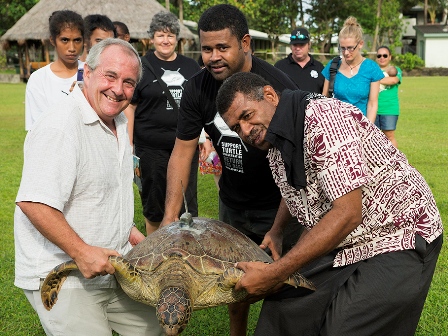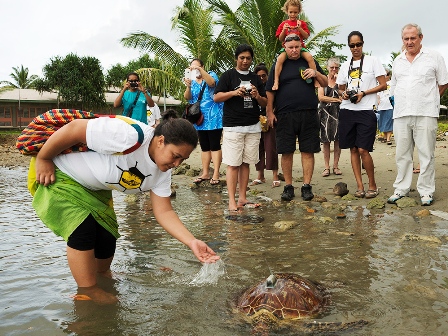
7 December 2013, Suva, Fiji - In a symbolic marking of the end of the 9th Pacific Islands Conference on Nature Conservation and Protected Areas, five turtles were tagged in Suva on Saturday 7th December and released.
The ceremony took place at the lower campus of the University of the South Pacific, to commemorate the dispersal of the vision, spirit and messages of the Pacific region for the future of our environment.
"The release of these turtles is symbolic of our hopes that the key messages and spirit of the 9th Pacific Islands Conference on Nature Conservation and Protected Areas, will, like the turtles, travel far and traverse boundaries and be a point of focus for gathering multiple partner support for their implementation," said Mr. David Sheppard, the Director-General of the Secretariat of the Pacific Regional Environment Programme (SPREP).
Two of the five turtles were mounted with satellite tags and christened, Bulou ni Laucala after the conference and Adi Laumei Madiba in commemoration of the late Mauigoa Lui Bell and Nelson Mandela.
This special event of the conference was particularly significant, as it was an opportunity to again bid farewell to a great friend, Lui Bell, who was instrumental in the conservation of marine turtles across the Pacific islands region. Those gathered at the ceremony also paid tribute to another Pacific island champion for marine turtle conservation - George Petro, who passed away in late November.

The tags were contributed by Mr. George Balazs of the National Oceanic and Atmospheric Administration (NOAA) Hawaii-based research programme as a tribute to Mauigoa Lui Bell and the Secretariat of the Pacific Regional Environment Programme region to further science based understanding of turtle migration for conservation.
"Satellite telemetry work has begun to unravel some of the mysteries associated with the travels of these ancient mariners. We have seen how the hawksbill, Lady Vini, navigated the EEZ's of seven Pacific island countries and territories covering nearly 4,500 kilometres in seven months," said Mr. David Sheppard.
"This information is crucial in helping us understand patterns of migration and consequently inform management decisions across countries and stakeholders including government agencies, communities and the public."
The voyages of Bulou ni Laucala and Adi Laumei Madiba through the Pacific islands will serve as a reminder of the need for collaboration and cooperation between SPREP members to ensure the survival of these ancient migratory animals in our waters.
To read more about the outcomes of the 9th Pacific Islands Conference on Nature Conservation and Protected Areas
No comments:
Post a Comment